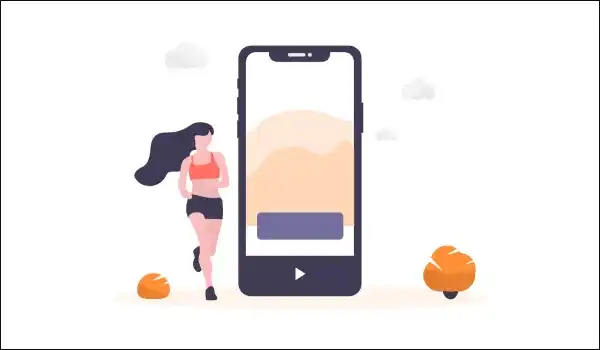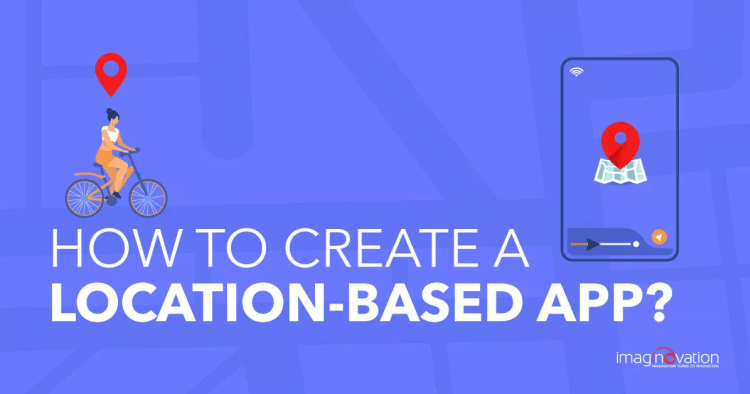Location-based apps are in hot trend these days. You will find many mobile apps integrated with geolocation features.
But, how to create a location-based app and how can it benefit your business?
The location-based mobile apps are not just for those who want to find directions, places, or people.
Retailers are already using technologies such as geofencing to send messages to people when they are nearby. Social networking apps allow users to tag locations while posting text, video, or pictures. Weather apps access the user’s location to send alerts about real-time weather conditions.
There are numerous use-cases of location-based mobile apps. In this blog, we will take a look at the steps to creating location-based apps, key features, and ideas.
Let’s start with basics first.
Location-based Apps: What Are They?
Location-based apps are mobile apps that allow businesses to offer their services based on the user’s location.
For example, you might have received a notification from Google to rate a restaurant that you just had dinner at.
Using the same technology, other businesses can send customized alerts to their users’ locations. The details of the location are transferred through Wi-Fi, cell tower, and satellite/GPS.
Now, the important question is, how this feature helps businesses improve their bottom-line?
How A Location-based App Benefits Your Business & Customers?
Location-dependent apps are becoming popular in the business world.
You can easily find apps of fitness clubs and restaurants with route tracking features, social network apps with geo-tagged pictures, dating apps with location services, and apps with map navigators.
Below are the four key functions of a location-based app that make it stand out.
- Information function: provides the user with information about the nearest objects.
- Social function: the capacity to know the location of other users.
- Communication function: the ability to register a place on the map, to leave feedback about visiting a place or read reviews of others, and to link your content (a photo or a text message) to a specific place on the map.
- Marketing function. Targeted incentive marketing campaigns for interaction with the consumer.
Let’s take a look at different ways businesses can use these functionalities to target and engage potential customers.
1. Provide Accurate and Quick Services
Location-based applications like Uber allow businesses to deliver accurate and prompt services to their customers.
GPS technology helps to find your customer’s precise location, and you can send your products or services with much precision in no time. It thus helps develop trust among your customers.
2. Real-time Relevant Offers
Companies can use location-based apps to provide their customers with relevant promotional offers at the apt time.
Such apps can help companies connect with the targeted set of audience and get the benefits of localization. Also, companies collect data about their customers’ behavior and make a personalized marketing plan.
3. Enhanced User Experience
User experience can make or break your app. With geolocation features, businesses in particular industries, such as travel, can enhance user experience and use engagement rate.
For example, a location-based travel app can allow its users to:
- Check the route and how to go from one place to another.
- The weather update along with the weather in the area they’re likely to visit.
- The popular visits across the location.
- The festivals and shows around the area.
- The historical places to visit along with the famous sites.
Similarly, a delivery services app can allow its customers to:
- Track the final product in real-time.
- Check the status of the product.
- Assess the expected arrival time of the product.
And, a dating app can allow its customers to:
- Meet as per their preferred location.
- Connect easily within a specific distance radius.
4. Navigation and Virtual Tour
Businesses have started using the concept of AR with location-tracking – which makes for impressive navigation and virtual tours.
Also, combining geolocation capabilities to your app can:
- Improve conversions
- Boost user-engagement
- Attract new customers. And,
- Provide high-quality data for business marketing.
Types of Location Based Apps
There are four types of location based apps which are as follows:
- Delivery and Navigation Apps: These apps utilize geolocation to facilitate services like arranging transportation or food delivery, tracking the route in real time, and identifying the location of both the service provider and the consumer. Popular examples include ride-sharing apps Uber and Lyft.
- Social Networks: These apps enhance social interaction by using geolocation to tag locations in posts, check-ins, and while using the app, thereby tailoring the social experience based on where users are located. Some well-known social media platforms that integrate these features are Instagram, Facebook, and Snapchat.
- Marketplaces: These e-commerce platforms often require location data to estimate shipping times and customize shopping experiences by showing items available nearby or within a reasonable delivery timeframe. Notable examples include Amazon and eBay, which utilize geolocation to streamline the user experience.
- Dating Apps: In the realm of online dating, these apps rely on geolocation to suggest potential matches within a specific radius, usually centered on the user's current location. This helps users find prospective partners in their immediate vicinity or in a chosen locale. Apps such as Tinder and Bumble are pioneers in this category, leveraging location data to facilitate connections based on geographical proximity.
Key Features of Location-based Apps

Here are the features that are trending up in the world of location-based apps.
1. Using the Map as the App Interface
A simple news feed interface is no longer trendy – its use is considered outdated. Map as your location-based app UI is a great feature, instead of the newsfeed.
Users can thus track any location-based updates in real time.
2. Notifications
Location apps can communicate better with users through helpful notifications. Users can receive information about the day’s deals, dangerous situations, or merely timely info about upcoming events in their local community.
The user will not have to scroll to find any information, as once it’s tagged in a location-based platform, the user is notified on the spot.
3. Information Filter
Location-based belongs to a different area. They can thus contain a vast amount of additional information.
A useful feature is when users can easily filter the information they require and get reminders only on the chosen topics. Moreover, the user can filter away info that’s not relevant to them.
4. Personalized Suggestions
Sending personalized suggestions is a cool feature. Once the app gets to know the user a bit better, it can send personalized suggestions about local events, news, or others based on the user’s profile, interests, and whom they follow.
5. Reward program
It is an excellent gamification feature for local businesses.
For example, users can get points or gather rewards for attending some events. Later, they can exchange these points for maybe free entry.
6. Location-based AR
When combined with GPS, augmented reality and location sensors are all set to transform the way we connect and move about our real, physical space.
UX related to sharing data, pictures, and other content on a location-based platform will be amazing.
Location-based App Development Technologies
Before exploring the different technologies used in the development of a location-based app, let us first understand how a location-based app works.
Location-based applications establish a connection with the satellites with the help of a mobile device’s operating system. The app gets information about the device’s location from the OS. By collecting and processing real-time data, it determines the movement and location of the device.
Read on to gather information on different technologies for building a geolocation app.
Outdoor Geolocation Technologies
1. GPS
GPS – Global Positioning System is a radio navigation system, and it uses radio waves between different satellites and mobile chips to provide information on location and time.
Do you know that our smartphones are equipped with a built-in GPS receiver chip that enables users to get access to the GPS? This allows devices to determine the current location with an accuracy of around 60 feet. To perform this function, GPS needs to get data from at least three satellites.
Let’s check the advantages and disadvantages of using GPS:
Advantages:
- GPS signals are available everywhere on the globe.
- The location is quickly determined.
- The accuracy of the result is usually high if conditions are good.
Disadvantages:
- High power consumption leading to reduced battery life**.**
- GPS signal does not pierce through any concrete walls, underwater, indoors, dense tree regions, and underground facilities.
- Insufficient reliability due to electromagnetic interference and other factors.
Despite some flaws in GPS technology, it is still considered a useful technology for geolocation app development.
2. Cell ID
In case it’s not possible to use the satellite signals for some reason, you can use cell towers to implement the geolocation app development.
This is a less popular approach due to its weak coverage outside of the big cities. Cell ID is used to determine the device location with the cell tower’s help.
Advantages:
- It’s an excellent choice for geolocation when it comes to major metropolises.
- There is no dependency on the operation and availability of the GPS signal in the area.
Disadvantages:
- Gives a low accuracy, only up to several hundred meters in some cases.
3. A-GPS – Assisted GPS
This technology combines GPS and Cell ID, which provides a higher level of accuracy than just Cell ID or GPS.
It generates combined data collected from the server and the satellite and then transmits the information through the Internet connecting using Wi-Fi or cellular connection.
Advantages:
- It provides good speed for determining the user location.
- Increased sensitivity in areas with tunnels, dense forest, etc.
- Better battery power consumption.
Disadvantages:
- Some A-GPS features work well only in the cellular coverage area.
4. Wi-Fi
As compared to the Cell ID, Wi-Fi covers smaller areas, which allows the technology to be more accurate. In geolocation app development, Wi-fi works well using RSSI and also using Google Maps.
For instance, by comparing the cellular data with Wi-Fi points, the RSSI (Receive a Signal Strength Indication) is applied. When it comes to Google Maps, the profile of frequently visited locations within Wi-Fi access identifies the user’s location.
Advantages:
- Easy to use. The user simply connects Wi-Fi using an active network, whose location is known.
- The location is determined quite quickly.
Disadvantages:
- It covers a smaller area compared to GPS.
- The system will work well only while the connection remains stable.
Indoor Geolocation Technologies
1. Geofencing
The use of geofencing in location-apps is gaining much popularity. It is built on GPS, which is used to determine how close a user is to a particular point. It is frequently used in the advertising area to provide users with relevant ads and offers. However, there are many other use cases available.
It is based on the use of a virtual perimeter with a radius of approximately 500 meters: for example, when a user enters the specified zone, a trigger fires and he receives a promotional SMS message or PUSH notification.
Advantages:
- It covers larger areas, in comparison with wi-fi.
- It brings in a lot of unique opportunities to improve a business strategy.
Disadvantages:
- Relatively high power consumption.
2. iBeacon & Eddystone
Apple and Google built iBeacon & Eddystone. These technologies rely on BLE – Bluetooth Low Energy signals. They can send some triggers to a device only when the user is within their reach.
Advantages:
- Both beacon and Eddystone have a high level of accuracy for user location.
- Ease of use.
Disadvantages:
- It’s expensive – an initial investment may be needed.
- Periodically, the device will have to be updated, as well as its batteries.
- Has a small radius of action.
Trending Ideas for Creating Incredible Location-based Apps
There’s much potential in app development with geolocation services. Let’s check these trending ideas for creating apps with some amazing location-based features.
1. Health and Fitness Apps
A good health and fitness app is always in demand. Many features can be added to make it an attractive app for users by integrating location services into it.

It can help users to track their workout activities. GPS data can monitor the user’s walking, cycling, and running routes and record additional fitness activities like swimming.
You can add more features for users to search for a running partner nearby or look for a place to grab a bite of healthy food after the exercise.
2. Tourism and Navigation

Imagine using a mobile app integrated with AR and location services to provide a guided tour to your user traveling to a new city.
This app can walk the user through the city by giving a virtual tour and notifications about the local business and sites.
3. Location-based Social Networking
Such apps can allow users to set a radius within which they’d like to join public chatting.

This app can also have features for live video streaming to update and find what’s happening nearby, finding local parties for travelers, or finding support groups in a new city.
4. Hospitality
Hotel apps using geolocation can offer services for self-check-in/out and mobile restaurant menus. You can even use in-door navigation systems to enable electronic keys.
Creating a Location-based App – The Step-by-Step Approach
The steps given below describe how you should approach the development process of a location-based app.
So, let’s get started!
1. Study the Market and Explore Opportunities
Exploring the market is the first step toward creating a successful location-based app. It’s essential to begin by researching similar geolocation apps currently available in the market and their unique features.
You can use this information to find the gaps your app is expected to fill and serve as a complete solution to the problem you’re trying to solve.
Also, you must do the following:
- Talk to a few potential users and try to understand their expectations.
- Read the reviews of similar apps.
- Research the existing market leaders in the domain.
2. Build A Unique Idea
Once you’ve checked out the competitive services, do the following:
- Short-list unique benefits of your app that will appeal to the users and set you apart from your competitors.
- Based on the above, build a unique idea for the location-based app.
3. Select A Reliable App Developer
The success of your app depends on the capacity of the app developer or the app development company. With the right app development company by your side, your app idea becomes a possibility.
It’s essential to:
- Opt for an app development company with the right expertise and a convincing portfolio in the domain.
- Ask the app developer for a list of the location-based apps they have developed in the past. Download these apps to measure their usability.
- Remember, the app company is not likely to perform better on your project than they did on these previous apps.
- Do check if the app company has any expertise in the platform you wish for your app: Android or iOS.
- Look for the best price and quality mix.
4. Select the Right Technology Stack
The tech stack of your app is determined by the app platform – iOS, Android, or Web and its business objectives.
You will need to add the right location-based SDK (Software Development Kit) to your app to access the most precise and accurate location data from the user’s device. Add maps based on Google Maps data to your app, with the help of Maps SDK for Android and iOS.
To display the location on the map, besides using Google Maps SDK, use Apple MapKit for iOS. Both are entirely accurate but offer differences in data quality, routes, AR, offline maps, and privacy.
Google Location Services API is used to locate Android devices. It has low power consumption, and it allows you to locate the user’s position via GPS, Wi-Fi, and Cellular networks.
If you want to add more location-based features to your app, you can consider some other frameworks – HERE, OpenStreetMap, MapBox, Foursquare API, and Facebook Places.
While making your choice, take into account that GPS-based apps drain a user’s battery quite quickly. Do take care to make these apps fast and reliable.
5. Decide on the Functions
The key features of every geolocation app include the following:
- Map view
- User-location detection
- Route mapping
- Places near me finder
- Location-based notifications
- Location history
You can add more features, depending on the purpose of your app. For example, you may consider adding a function to:
- Set the radius
- Rating and recommendations
- Sharing location with contacts
- Weather forecast pinned up on the map
- Location search by photos
- Real-time updates on traffic congestion
Do remember to keep the number of features to a minimum for the initial version of your app. Building an MVP first is advisable since it’s a low-risk strategy to verify your idea.
6. Create UX and UI
Create a visual prototype of your app.
Start working on what your app will look like and which screens it’ll include. Your app design should be clean and intuitive. This will validate your idea.
7. Make the App Secure
With stricter regulations in data safety, it is recommended that the app’s security is given importance. During this step, your app will be put through security and data privacy compliance.
Users’ data is the most valuable asset you can have, and you should ensure you have proper processes to collect and store this data and manage any potential security risks. You must:
- Work on data safety to make your GPS app secure.
- Remember that your data can be lost to the accidental deletion of files and folders. In this case, you must have data recovery software.
- Make sure you comply with the local regulations in the countries you want to target your app.
8. Develop and Test
The coding process is done in the development phase. This is where the back-end coding happens. You must never ignore the importance of app testing. Thorough testing helps in removing bugs and ensuring the quality of the code.
After it goes through all the steps mentioned above, your app is all set for its launch.
9. Launch and Maintenance
So once the development is over, it is time to launch the app. However, this is not the endpoint. It usually happens that apps also need technical support after the launch. For example, Apple and Google may launch new requirements for iOS and Android apps. In such a case, you will have to update the solution and fix the bugs. Continuous monitoring and updates are crucial to ensure that your app remains functional and secure in the ever-evolving tech landscape. Regular updates not only help in fixing bugs but also in adding new features that meet the users' evolving needs.
Build A Powerful Location-Based App with Imaginovation
Creating a location-based mobile app can be an exhausting process. If you want to know more about geolocation services for app development, get in touch with us.
We will gladly help you develop the best location-based app for your business. Let’s talk.
Ready to build an app, but not sure where to start?
We've got you covered. Click the button below to get started.





